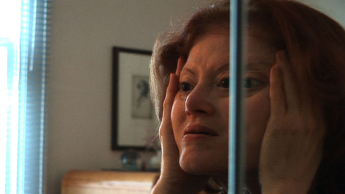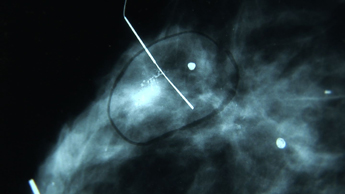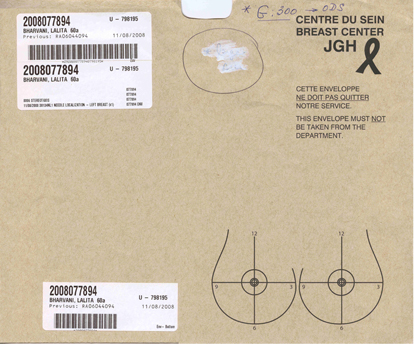This week I’m driving up to Montréal to film the most bloody scene I’ve ever shot. My documentary film subject, Lalita Bharvani, is having open-heart surgery, and the hospital has surprisingly granted me permission to film in the operating room. I shoot as a one-woman band. I’m not 100% sure I can handle the sight of doctors sawing open the chest of someone I care about, and performing delicate surgery on her most vital organ. But it is a major event in my subject’s life, and probably the closing scene of my film, so I’ll have to find a way (hello, tripod!). In any case, it’s Lalita and the surgeon who have the biggest task at hand.

I have been filming Lalita since 2008 for a documentary film that explores the idea of the body as an archive: that our experiences write themselves on our bodies as we grow and age, and that our bodies in turn imprint the world with immigration papers, medical records, photographs, and other documents.
Lalita’s life provides an interesting vehicle to explore these themes, because her body has gone through remarkable transformations that often seem triggered by where she lives and how she feels.
As a child in Bombay in the early 1950s, Lalita began to develop white patches on her leg, caused by a skin condition called vitiligo. Her mother worried that this “defect” would prevent Lalita from finding a good husband. Lalita’s childhood shame is part of what pushed her to leave India to study in Paris. There she fell in love with a French Canadian man. But when they married and moved to a working-class suburb of Paris, neighbors mistook Lalita for an Arab and discriminated accordingly. Lalita believes this prejudice affected her health, causing the skin pigment to begin disappearing from her face. She and Pierre decided to leave Paris and settle in Montréal.
Despite a happy marriage, Lalita found North American life lonely. Her solitude was compounded when ovarian cancer left her unable to bear children. Luckily, her mother’s visit from India – and her mother’s spicy food – helped Lalita recover from the hysterectomy. But the cold air of Montréal accelerated her pigment loss; within a year of arriving to Canada, Lalita had become totally white. Now 60, Lalita is fighting breast cancer and heart disease, as her mother faces the end of life in India. A radiant, charismatic woman, Lalita finds strength in her Hindu spirituality and her strong relationship with her husband Pierre.
My concept for this film – and the two-channel installation version of it – grew out of Lalita’s own description of the seemingly causal relationships between her geographical location, her emotional state, and her physical health. “I suppose that is the whole process of living,” she says, after learning that her breast cancer has recurred. “You know, there’s the wear and tear on so many levels on your body and of your psyche. And of course it leaves its indelible mark or its stamp on you.”

Do one’s life experiences mark one’s body – beyond the obvious scars and tattoos? Is the body somehow imprinted, like a passport getting stamped, by the place where one lives? Can the body be read as a record of all that transpired to the soul inside?
I went to China in 1995 to meet my mother’s relatives, whom she had left behind 50 years earlier. I was struck by how much my mother’s first cousins resembled her physically. And yet their facial expressions were completely different – formed, perhaps, from 26 years of exile in Inner Mongolia, or from persecution during the Cultural Revolution. Having left China at age eight, my mother surely had a much easier life – and I can see it in her face.
Of course, this kind of thinking can enter dangerous territory. As Alan Sekula describes in The Body and the Archive, the mid-nineteenth century saw the rise of physiognomy and phrenology, which “shared the belief that the surface of the body, and especially the face and head, bore the outward signs of inner character.” On the basis of this idea, police departments and courts thought they could identify members of the “dangerous classes.”
I am not really trying to say that you can read a person’s character from his or her face. I’m looking at the body as a record written by life experiences – and interpreted through the complex sets of meaning imposed from the outside. Henri Bergson postulated the body as a set of images inscribed in a system of representation:
“My body is, then, in the aggregate of the material world, an image which acts like other images, receiving and giving back movement, with, perhaps, this difference only, that my body appears to choose, within certain limits, the manner in which it shall restore what it receives.” (Matter and Memory)

In thinking about how to handle Lalita’s story, I saw the richness in the collection of documents related to her body: immigration papers, medical scans, photographs, ESL homework she has graded, etc. This adds another dimension to my investigation: the body is not only an archive being written as it moves through time and space – it is also writing on the archive of the world as it goes along. The body sheds layers of documents like the skins in Balzac’s theory (as described by Félix Nadar):
“All physical bodies are made up entirely of layers of ghostlike images, an infinite number of leaflike skins laid one on top of the other. . . every time someone had his photograph taken, one of the spectral layers was removed from the body and transferred to the photograph. Repeated exposures entailed the unavoidable loss of subsequent ghostly layers, that is, the very essence of life.” (My Life as a Photographer)
I wonder what Nadar would think of the current proliferation of digital imaging. We are certainly scanned, recorded, and digitally reproduced as never before. Does that mean we are losing more of our “ghostly layers”?
Another thing is obviously very different today: we live in contact with people and places all over the world. Lalita is a quintessential global citizen, having “passed” in both majority and minority cultures on three continents. Lalita’s body seems to reflect her feelings about traversing national and cultural frontiers. As I edit this film, I realize that her journey reveals the impact of globalization on her body.
Lalita is a comfortable, middle-class person from one of India’s international families. Globalization reveals itself in her body very differently than in bodies that find themselves in other situations. For example, maybe some workers in the maquiladora plants along the U.S.-Mexican border have NAFTA-inspired tendonitis. (Others have become victims of a stream of rape-murders along the border – terrifyingly described in Lourde’s Portillo’s film Señorita Extraviada). Call centers in Mumbai train their workers’ voices to resemble middle-American accents (see the film John & Jane for more on this). The international sex trade moves and destroys bodies in unspeakable ways.
I could go on about this, but my own body is pretty tired. I’m finishing this essay from Montréal, after a long day of filming in the operating room. I am happy to report that Lalita’s surgery went fine – the quadruple bypass was successful. As a filmmaker, it was certainly hard to resist the obvious symbolism when she told me that the 80% blockage in a major heart artery became clear just two days after her mother passed away in India. A heartache, indeed.


